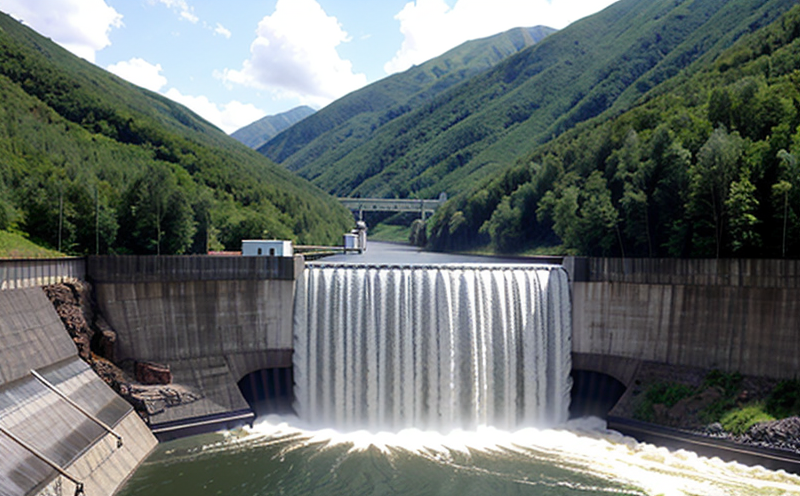IEC 60609 Cavitation Erosion Testing of Turbines
The International Electrotechnical Commission (IEC) Standard 60609 defines the methods for testing cavitation erosion in hydraulic turbines. This standard is crucial for ensuring that turbines used in hydropower plants can withstand the harsh operating conditions they face, particularly during periods of high water flow and pressure variations. Cavitation occurs when bubbles form due to a drop in local pressure below the vapor pressure of the fluid, which then collapse, creating shock waves that can lead to severe erosion on turbine blades.
The IEC 60609 test involves subjecting turbine components to controlled cavitation conditions to assess their resistance. The testing process is designed to simulate real-world operating environments where turbines are exposed to varying water flow rates and pressure fluctuations. This ensures that the equipment can operate safely and efficiently over its expected lifetime without significant degradation due to cavitation erosion.
The standard outlines several key parameters for conducting these tests, including:
- Test Setup: The setup involves a closed-loop system where the turbine components are submerged in water. The water is circulated through the turbine under controlled conditions to simulate cavitation.
- Sample Preparation: Turbine blades or other relevant components are carefully prepared to ensure they represent actual operational parts.
- Testing Conditions: The test parameters include specific flow rates, pressures, and durations that mimic real operating conditions. These can be adjusted based on the turbine's design and intended use.
- Data Collection: Various sensors are used to monitor pressure, temperature, and fluid flow during the tests. This data is crucial for understanding the cavitation behavior and its impact on the turbine components.
The results of these tests are critical in ensuring that hydropower systems can operate reliably under challenging conditions. By adhering to IEC 60609, manufacturers and operators can have confidence that their turbines will meet or exceed performance expectations, thereby reducing maintenance costs and extending the life of the equipment.
The test results provide valuable insights into the durability and reliability of turbine components. This information is essential for quality managers, compliance officers, R&D engineers, and procurement teams who are responsible for ensuring that hydropower systems meet international standards and perform optimally in their intended applications.
Why It Matters
The integrity of the turbine blades is vital to the efficient operation of hydropower plants. Cavitation erosion can lead to premature wear, reduced efficiency, and ultimately, costly repairs or replacements. By ensuring that turbines meet the stringent requirements set forth by IEC 60609, operators can mitigate these risks and maintain optimal performance.
The standard also plays a crucial role in the sustainable development of hydropower as it helps to extend the life of turbine components, thereby reducing environmental impact through less frequent replacements. This is particularly important in regions where the availability of raw materials for manufacturing new turbines may be limited or costly.
Furthermore, compliance with IEC 60609 can enhance a company's reputation and market position by demonstrating a commitment to quality and safety standards. This can be especially advantageous when bidding on contracts or seeking certifications that recognize adherence to international best practices.
In summary, the significance of IEC 60609 lies in its ability to provide a robust framework for evaluating cavitation erosion resistance, ensuring that turbines perform reliably under challenging conditions and contribute positively to sustainable energy production.
Why Choose This Test
Selecting the appropriate testing method is critical for ensuring the reliability and longevity of hydropower systems. The IEC 60609 cavitation erosion test offers several advantages over other methods:
- Realistic Simulation: It provides a realistic simulation of the operating conditions that turbines encounter in the field, making it an effective predictor of performance.
- Standardized Procedures: The test adheres to internationally recognized standards, ensuring consistency and comparability across different manufacturers and facilities.
- Data Accuracy: With comprehensive data collection techniques, IEC 60609 allows for precise measurement of cavitation effects on turbine components.
- Cost-Effective: By identifying potential issues early in the development process, this test can save significant costs associated with late-stage failures or replacements.
In addition to these benefits, the test also facilitates compliance with regulatory requirements and industry best practices. This ensures that hydropower systems meet all necessary safety and performance standards, thereby enhancing overall system reliability and safety.
For companies involved in the design, manufacturing, and operation of hydropower systems, choosing IEC 60609 cavitation erosion testing is a strategic decision that can lead to improved product quality, reduced operational costs, and enhanced market competitiveness.
Competitive Advantage and Market Impact
The adoption of IEC 60609 cavitation erosion testing provides significant competitive advantages in the hydropower industry. By demonstrating adherence to this stringent standard, companies can differentiate themselves from competitors who may not meet these rigorous requirements.
Compliance with international standards like IEC 60609 is increasingly becoming a key differentiator for suppliers of hydropower equipment. It signals to customers and partners that the company prioritizes quality and safety, which are critical factors in the selection process for large-scale infrastructure projects.
The test results can also be used as marketing materials to highlight the superior performance and reliability of products. This can enhance brand reputation and attract more business opportunities. Moreover, meeting these standards can open doors to new markets where international certifications are required or preferred.
In addition to direct benefits for suppliers, there is a broader impact on the industry as a whole. By setting high standards for cavitation erosion testing, IEC 60609 helps to improve overall product quality and safety, which contributes to more sustainable and reliable hydropower systems.
For companies involved in the design, manufacturing, and operation of hydropower systems, choosing IEC 60609 cavitation erosion testing is not just a compliance requirement but also an investment in long-term success. It helps build trust with stakeholders, enhances product quality, and opens up new business opportunities.





